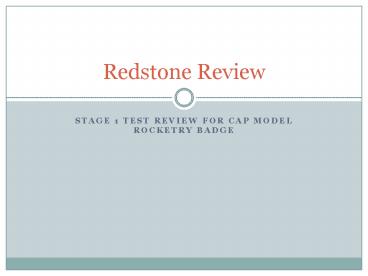Stage 1 Test Review For CAP Model Rocketry Badge - PowerPoint PPT Presentation
1 / 9
Title:
Stage 1 Test Review For CAP Model Rocketry Badge
Description:
Redstone Review STAGE 1 TEST REVIEW FOR CAP MODEL ROCKETRY BADGE Some Things To Know About The Test Closed Book 10 Questions Need a 70% to pass No Time Limit ... – PowerPoint PPT presentation
Number of Views:1109
Avg rating:3.0/5.0
Title: Stage 1 Test Review For CAP Model Rocketry Badge
1
Redstone Review
- Stage 1 Test Review For CAP Model Rocketry Badge
2
Some Things To Know About The Test
- Closed Book
- 10 Questions
- Need a 70 to pass
- No Time Limit
- Questions come from CAP Model Rocketry guide
book. - Missed questions will be reviewed.
- Failures will retest next week.
3
Chinese
- Created a simple explosive powder made from
saltpeter, sulfur and charcoal. These powders
were used to create small explosions in religious
festivals. - Developed rocket propelled arrows called Fire
Arrows. Used to fight invading Monguls in 1232
at the Battle of Kai-Keng.
4
The British
- Sir Isaac Newton developed the 3 Laws of Motion
and laid the scientific foundations for modern
rocketry. - William Congreve took a scientific approach to
develop more sophisticated rockets. Standardized
gunpowder composition and added
flight-stabilization guide sticks. - William Hale developed spin stabilization.
Escaping exhaust gases strike small vanes at the
bottom of the rocket causing it to spin.
5
Konstatin Eduardovich TsiolkovskyFather of
Space Travel
- Russian teacher who made some of the first
mathematical computations for rocket flights into
space. - Inspired by the Jules Verns novel From the Earth
to the Moon. - In 1903, Tsiolkovsky published an article titled
"The Exploration of the World Space with Jet
Propulsion Instruments and is considered to be
the first scientific proposal for space
exploration. - Formulated relationships between the changing
mass of a rocket as it burned fuel, the velocity
of exhaust gases and the rockets final velocity. - Illustrated a rocket engine that was fueled by
liquid hydrogen and oxygen
6
Hermann Oberth
- Also inspired by Jules Verns book.
- Published his 1923 thesis on rocket development
called The Rocket into Planetary Space. Covered
concepts such as - rocket's fuel consumption
- fuel handling hazards, the dangers of working
with solid propellants and the possible hazards
to humans. - Introduced the idea of multi-staging. When the
first stage fuel is burned off, that stage should
be discarded. - As the rocket flies higher and higher, the mass
of the propellant becomes less while the mass of
the rocket remains unchanged. This means that the
rocket becomes heavier in relation to the
engine's ability to provide thrust
7
Robert GoddardFather of Modern Rocketry
- Built a successful liquid-fuel rocket that was
launched on March 16, 1926 - The rocket flew for just 2.5 seconds and rose to
a height of only 41 feet. - Proved that liquid-fuel rockets worked. One of
the great advantages of liquid-fuel is that it
can be controlled, whereas, solid-fuel burns to
completion once ignited. - Later launches were witness by Charles A.
Lindberg, first person to fly solo across the
Atlantic from New York to Paris.
8
Werner Von Braun
- Follower of Hermann Oberth in college and earned
a PhD. in physics. - Werner von Braun was the team leader of a group
that developed the V-2 ballistic missile for Nazi
Germany during WWII. - The V-2 was incredible for its time and was
eventually used in the rocket development program
of the United States. - The V-2 was 46 feet long, weighed 27,000 pounds
and had a sophisticated, reliable liquid fuel
propellant system. - Could fly at speeds in excess of 3,000 miles per
hour and would deliver a 2,200-pound warhead to a
distance of 500 miles from its launch site. - Braun managed to get many of his top rocket
scientists to surrender to the Americans. This
enabled the U.S. to get most of the science and
test vehicles from the Germans. Enabling America
to build its space program.
9
Test Time!
- Good Luck!































